Chemical bonding notes for jee 2023
A chemical bond is an atom-to-atom attraction. This attraction can be explained by differences in the behaviour of atoms’ outermost or valence electrons. These actions blend effortlessly into one another in a variety of situations, leaving no visible distinction between them. Differentiating between distinct kinds of relationships, which result in diverse characteristics of condensed matter, is still relevant and common.
Importance of Chemical bonding:
Chemical bonding aids in the combining of atoms or molecules. It also assists components with the same or other substances in forming bonds with one another. Chemical bonding allows solid, liquid, and gaseous matter to exist in nature.
Any of the connections that contribute for the combination of atoms into macromolecules, ions, crystals, as well as other stable organisms that make up the recognisable compounds of everyday life are referred to as chemical bonding.
When atoms come close together, their nuclei and electrons contact and tend to disperse themselves in the system in such a way that the amount of energy is lower than in any other configuration. When the overall energy of a collection of atoms is less than the sum of the strengths of the component atoms, they bind together, and the energy difference is known as the bonding energy.
Types of Chemical Bonds
- Ionic Bond
- Covalent Bond
- Metallic Bond
1.Ionic Bond:
The electrostatic interaction between positive and negative ions in a chemical molecule forms an ionic bond, also known as an electrovalent bond. A bond is created when the valence (outermost) electrons of one atom are irreversibly transferred to another atom.
Ionic bonds are formed by a cation and also an anion. The bond is formed when an atom, often a metal, releases one or more electrons and transforms into a positive ion, or cation. A non-metal atom can accept the electron(s) needed to create a negative ion, or anion.
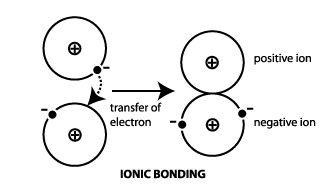
Examples of Ionic Bond
- LiF – Lithium Fluoride
- LiCl – Lithium Chloride
- LiBr – Lithium Bromide
- LiI – Lithium Iodide
- NaF – Sodium Fluoride
- NaCl – Sodium Chloride
- NaBr – Sodium Bromide
- NaI – Sodium Iodide
- KF – Potassium Fluoride
- KCl – Potassium Chloride
2.Covalent bond
A chemical link involving the exchanging of electron pairs among atoms is known as a covalent bond. Shared pairs or bonding pairs are the permanent balance of attractive and repulsive forces between atoms when they share electrons, while covalent bonding is the stable balance of attraction and repulsion between atoms when they share electrons.
When two or more atoms exchange one or maybe more pairs of electrons, they create a covalent connection. At the same time, these particles are collected to both atomic nuclei. When the difference in electronegativity of two or more elements is too tiny for an electrostatic interaction to produce ions, a covalent bond is established.
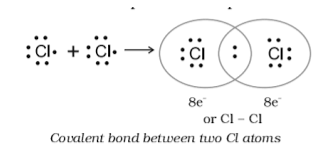
- Polar covalent bond:
The electrons in a polar covalent bond are unequally shared by the atoms, and they spend more time near to one than the other. Slightly positive (+) and slightly negative (–) charges form in different sections of the molecule due to the uneven distribution of electrons between both the atoms of different elements.
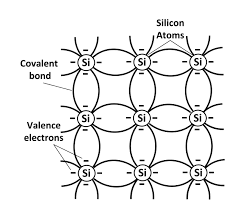
ii . Non-Polar Covalent Bond:
A nonpolar covalent link is a sort of chemical connection that occurs when two atoms share electrons evenly. As a result, the number of electrons distributed by neighbouring atoms in an atom would be the same. Because the electronegativity difference is usually minimal, the covalent bond sometimes is referred to as nonpolar.
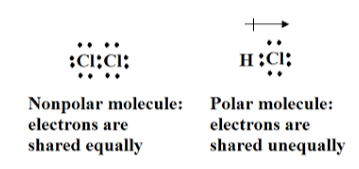
3.Metallic Bond:
Metallic bonding is a type of chemical bonding that occurs when positive charged ions and conductance electrons attract each other electrostatically. It may be defined as the sharing of delocalized electrons in a structure by positively charged ions (cations). Metallic bonding determines several physical properties of metals, including hardness, ductility, thermal and electrical resistance and permeability, opacity, and brightness.
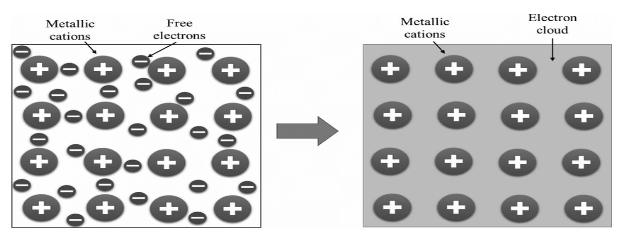
Chemical Bonding and Molecular Structure
A chemical bond is an atom-to-atom attraction. This attraction can be explained by differences in the behaviour of atoms’ outermost or valence electrons. These actions blend effortlessly into one another in a variety of situations, leaving no visible distinction between them. Differentiating between distinct types of bonds, which result in diverse condensed matter characteristics, is still relevant and common.
Molecular Structure:
The placement of the atoms, not really the electrons, is described by molecular structure. We call the geometry that contains all pairs of electrons the electron-pair geometry to distinguish between these two circumstances. The molecular structure is the structure that solely comprises the location of the atoms in a molecule.
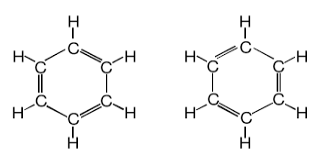
Conclusion:
Chemical bonding is the attracting force that keeps diverse components (atoms, ions, and so on) together and stabilises them by causing them to lose energy. As a result, the strength of chemical bonds between constituents determines the stability of chemical compounds; the stronger the connection between constituents, the more permanent the final complex.
There are one or more types of elements that make up matter. Except for noble gases, no other element exists in nature as an individual atom under normal conditions. A group of atoms, on the other hand, is discovered to exist as a single species with distinct properties. A molecule is a collection of atoms like this.
Clearly, some force is at work in the molecules to keep these constituent atoms together. A chemical bond is an attractive force that holds a set of elements (atoms, ions, and so on) together to form a chemical species and chemical bonding is the study of various bonds existing between atoms or molecules. This chapter explains why atoms combine with each other and make a new project and also explains their arrangement in a definite shape.
Class 11 chemistry chemical bonding:
Chemical Bond
The chemical bond is the force that holds the atoms of a molecule together.
Octet Rule
According to the octet rule, atoms gain or lose electrons in order to achieve an outer shell electron configuration that is closest to that of a noble gas. This rule is used to measure the attraction force between atoms informally.
Valence Electrons
Valence electrons refers to the electrons present in the outermost shell, which takes part in chemical combination.
Kossel’s Statements on Chemical Bonding
- In the periodic table, noble gases separate the strongly electropositive alkali metals from the very electronegative halogens.
- Gain of electron and loss of electron are used to form anion and cation by halogens and alkali metals, respectively.
- The noble gas configuration is acquired by both negative and positive ions.
- Electrostatic attraction holds the negative and positive ions together.
Types of chemical bonding
Ionic bonds, covalent bonds, hydrogen bonds, and van der Waals interactions are the four types of chemical bonding.
Ionic or Electrovalent Bond
The complete transfer of electrons from one atom to another forms an ionic or electrovalent bond. It is usually formed through the interaction of metals and non-metals.
Covalent Bond
A covalent bond is a two-atom interaction in which one or more electrons are shared to help each atom satisfy the octet rule. Normally, this interaction occurs between two nonmetals.
Factors affecting the formation of Ionic bond
Ionisation enthalpy
- The amount of energy required to remove an electron from the outermost shell of an isolated gaseous atom in order to transform it into a cation is known as the ionisation enthalpy of any element.
- As a result, the lower the ionisation enthalpy, the easier it will be to generate a cation and the greater the likelihood of forming an ionic connection. As a result, alkali metals are more likely to establish an ionic bond.
- For example,in the formation of Na+ ion, I.E = 496 kJ/mol
Bond Angle
The bond angle is the angle formed by two bonds that share a common atom. Bond distance is the distance between the nuclei of bonded atoms. Bond angles and distances can be used to describe a molecule’s geometry. A plane is formed by groups of three adjacent atoms. A chain of four bonded atoms consists of three bonds. Each group of three contiguous atoms lies in a plane. The dihedral or torsional angle of the two outer bonds is the angle formed by these two planes. The projection of the four atoms down the line of the central bond, also known as a Newman projection, is another way to visualise this angle. The torsional angle is the angle formed by the projections of the two outer bonds.
Bond Enthalpy
- It is the amount of energy necessary to break one mole of a specific type of bond and separate it into gaseous atoms. Bond enthalpy, also known as bond dissociation enthalpy or simple bond enthalpy, is a measure of how strong a bond is.
- The enthalpy of a bond is measured in kJ mol-1.
- The stronger the bond, the higher the enthalpy of the bond.
- The H—H bond enthalpy in hydrogen, for example, is 435.8 kJ mol-1.
Bond Order
- The number of electrons involved in bonds between two atoms in a molecule is measured by bond order. It is used to determine how stable a chemical bond is.
- The stronger the chemical bond, the higher the bond order. Bond order is usually equal to the number of bonds between two atoms.
- Bond order of
Valence Shell Electron Pair Repulsion (VSEPR) Theory
The following are the main postulates:
- The number of electron pairs (bound or non-bonded) around the core atoms determines the exact shape of the molecule.
- Because the electron pairs exist around the centre atom and the electron clouds are negatively charged, they have a tendency to reject one other.
- Electron pairs try to align themselves in such a way that the repulsion between them is minimised.
- The electron pairs are arranged at maximum distance in the valence shell, which is modelled as a sphere.
- A multiple bond is handled as if it were a single electron pair, as are the electron pairs that make up the bond.
Valence Bond Theory
- It is based on the notion of atomic orbitals and atoms’ electronic configuration.
- One atom’s nucleus is drawn to its own electron and the electron of the other, and vice versa.
- Between the electrons of two atoms and the nuclei of two atoms, repulsive forces form. Attractive forces pull the two atoms closer together, while repulsive forces pull them apart.
Conclusion
A chemical bond is a lasting attraction between atoms, ions, or molecules that enables chemical compounds to form. Ionic bonds are formed by the electrostatic force of attraction between oppositely charged ions, while covalent bonds are formed by the sharing of electrons. Molecular geometry is the three-dimensional arrangement of the atoms that make up a molecule. It contains the general shape of the molecule, as well as bond lengths, bond angles, torsional angles, and any other geometrical properties that govern the position of each atom

.jpg)






No comments:
Post a Comment